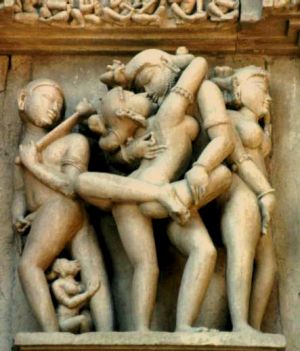Khajuraho Group of Monuments

Khajuraho is a city in the Indian state of Madhya Pradesh, located about 385 miles (620 kilometres) southeast of Delhi, the capital city of India.
One of the most popular tourist destinations in India, Khajuraho has the largest group of medieval temples famous for their erotic sculpture. The name Khajuraho is derived from the Hindi word khajur meaning a date palm.
The city was once the religious capital of the Chandela Rajputs, a tribal dynasty who ruled this part of India from the 10th to the 12th centuries. The Khajuraho temples were built over a span of a hundred years, from 950-1050 AD. The whole area was enclosed by a wall with eight gates, each flanked by two golden palm trees. There were originally over 80 temples, of which only 22 now stand in a reasonable state of preservation, scattered over an area of about 8 mile² (21 km²).
Temples of Khajuraho
Khajuraho is known the world over for its temples, sex, architecture and sculpture. The construction of these Temples are thousand-year old took a little over two centuries, in terms of architecture of these temples, they form the high peak of the north Indian 'nagara' style. Of the 85 temples believed to have been built between the 9th and 12th centuries only 20 have survived, many in splendid condition, others having given way to the ravages of time and nature.
The hub of tourist activity is the group of temples built by the Chandela Rajputs, who according to legend can be traced as descendants of the moon god. The head of the clan is believed to have been a valiant warrior who fought lions bare-handed (hence the emblem, frequently seen at the temples, of a warrior grappling with a lion); he is said to have ordered the building of the temples as a means of salvation for his mother, Hemvati, who was ravished by the Moon god. The spate of temple building which began about the middle of the 9th century and continued until the early 12th century must have used the skills of thousands of sculptors, architects and masons; unfortunately, there is almost no record of this activity in the annals of Indian history. By the time the last temple was completed the Chandela dynasty had sunk into oblivion.
Khajuraho was the Chandela capital for only a brief period; they ruled for the most part from Kalinjar and other parts of the Bundelkhand region, with Khajuraho remaining their religious center. The most important aspect of the temples is the abundance of sculptures that decorate the facades and interiors of the shrines.
This profusion of images concentrates on conventional divinities, but also on celestial beauties, the female form in general and, controversially, to graphic sexual representations. Over the years a number of explanations have been forthcoming for the presence of erotic sculptures at what was essentially a religious centre; no single theory, however, has been able to explain their profuse expression.
As Chandela power diminished, the importance of their sometime-capital also waned. Its heavily forested terrain could not provide much revenue, and served to deter invading Muslim armies. The temples were never entirely lost, for villagers and tribal inhabitants of the region were familiar with them. While early travelers such as Alberuni and lbn Batuta had reported the presence of the temples, they were not dwelt upon, possibly because of their being abandoned and overgrown by bushes and weeds.
Burt the British engineer who is credited with their 'discovery' in the mid-19th century announced their presence to the world, and the first major data on them was collected by General Alexander Cunningham in his Survey of India reports. Early this century there was some interest in the temples, but their inaccessibility made their study and regular travel to the site impossible. Over the years, roads were laid and the minimal facilities provided; then, a couple of decades ago, the first luxury hotel project revived interest in the region, and the resurrection of Khajuraho began.
The Khajuraho group of monuments has been listed as a UNESCO World Heritage Site.